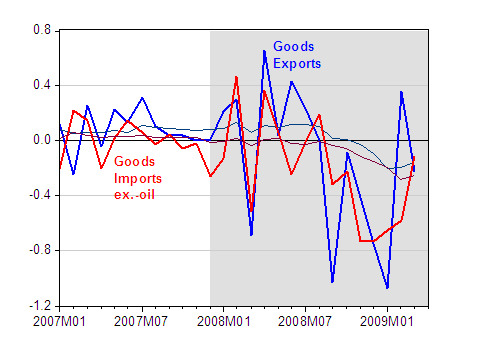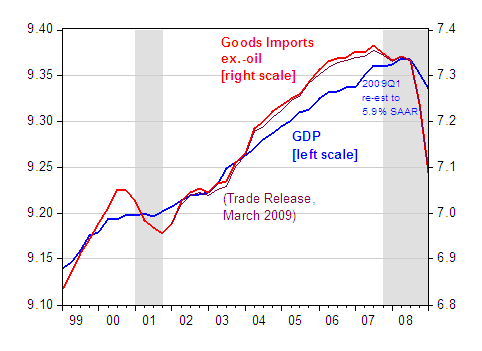My views on the short term prospects for GDP growth at home and abroad were little changed (relative to this post) by the information in the March trade release. Goods imports are collapsing, albeit at a slower but still substantial rate, and goods exports are declining, with high volatility.
First consider the growth rates of real goods imports ex.-oil and real goods exports.

Figure 1: Month-on-month annualized growth of real goods imports ex.-oil (bold red), and of real goods exports (bold blue); and year-on-year growth rates (respectively teal, purple); all in Ch.2000$, calculated as log differences. NBER defined recession dates shaded gray, assuming recession has not ended by May 2009. Source: BEA/Census, March trade release, NBER, and author’s calculations.
Note that imports seem to be recovering. But it’s important to look closely at the vertical axis; month-on-month annualized growth rate is minus 10.9%, and the year-on-year growth rate is minus 24.8%.
Goods exports month-on-month annualized growth rates have dropped back into negative territory — at minus 22.3%. But even the year-on-year rate is -15.4%. So here, I’m in agreement with Brad Setser’s observations [1], [2] — trade has collapsed and there’s little evidence that there’s an incipient recovery.
Now, turning to the implications for future growth — I believe that a recorded decline in imports implies (conditional on observing other data) an increase in contemporaneous GDP, but a decrease in future growth prospects (holding all else constant).
It turns out that updating the advance release figures for imports with the actual March import numbers changes the implied GDP for 2009Q1 (to -5.9% SAAR, as opposed to -6.1% [3]), but does not change the overall picture regarding imports in a perceptible manner (see for instance Figure 1 in this April 27th post).

Figure 2: Log GDP (blue, left scale), log goods import ex.-oil from NIPA (red, right scale), estimated from trade release (purple, right scale), all in Ch.2000$, SAAR. 2009q1 estimate is based on actual January-March data, rescaled to match in 2008Q4 NIPA data; 2009Q1 GDP number is edited to reflect -5.9% growth, rather than officially reported -6.1%. NBER recession dates shaded gray. Source: BEA, GDP advance release of 27 April 2009, March trade release, NBER, and author’s calculations.
Lower imports implies lower future GDP to the extent that lower imports are associated with lower exports (vertical specialization), and lower consumption (since at least 22% of imports — if one includes cars — are for consumption, as of last year). On the other hand, the inventory channel works in the other direction — if inventories have fallen along with imports, then rebuilding of inventories in the future will have to be done in part with greater production. I’m betting this latter channel is not as big as the first two, as I argued in this post.
In addition, I’ll observe that some observers must be assuming some persistence in the trade balance, and assuming a smaller April trade deficit implies higher GDP in 2009Q2 [4], conditioning on everything else (consumption, investment, government spending) in that quarter.
So, while the sharp decline in trade flows might be over, I’m not so sure that we’ll see trend increases soon (although Deutsce Bank believes trade flows in dollar terms might increase in the near future), especially given the downside surprise in retail sales reported today.
The March real trade balance was barely changed from the Feb trade balance. I doubt it will make a significant difference in the 1st quarter real gdp estimate.
Trade balance
(mill 2000 $)
dec…-42989
jan…-43978
feb…-35665
mar…-35900
Menzie,
Good post. Surprisingly I agree with your assessment.
I’ll bet the March was the “high” point for YoY drop in imports (and exports.) April will look worse, and May probably worse again.
Here are the YoY declines in intermodal (mostly containers) rail traffic by month:
Jan: -12.9%
Feb: -18.7%
Mar: -14.9%
Apr: -17.9%
May (1 wk): -21.0%
Other rail traffic is down even more and the second derivative is most definitely negative, the trend is accelerating.
The green shoots were the result of a dead cat bounce.
I am depressed by the change in trend. If the trade deficit fails to fall further, or worse, increases in tandem with any recovery, we will be in trouble down the road, as it will mean that fundamental needed rebalancing is not in the cards. A reduction in the deficit from 6% of GDP to 3% is good, but not good enough over the long haul. The ROW needs to find an alternative way to maintain growth, and sooner is better than later.
Article by Mark Steyn about the expanding nanny state, and inevitable societal collapse that follows :
http://www.hillsdale.edu/news/imprimis/archive/issue.asp?year=2009&month=04
Mark Steyn? You quote Mark Steyn and expect to be taken seriously?
Yes, please keep your doom and gloom confined to that sourced from accepted sources, which do not include conservative writers with the same (lack of) credentials as most left-of-the-aisle doom and gloomers.
PM: One could be “doom-and-gloom” and try to substantiate with facts. In by opinion, that’s not a characterization of Mr. Steyn’s writings.